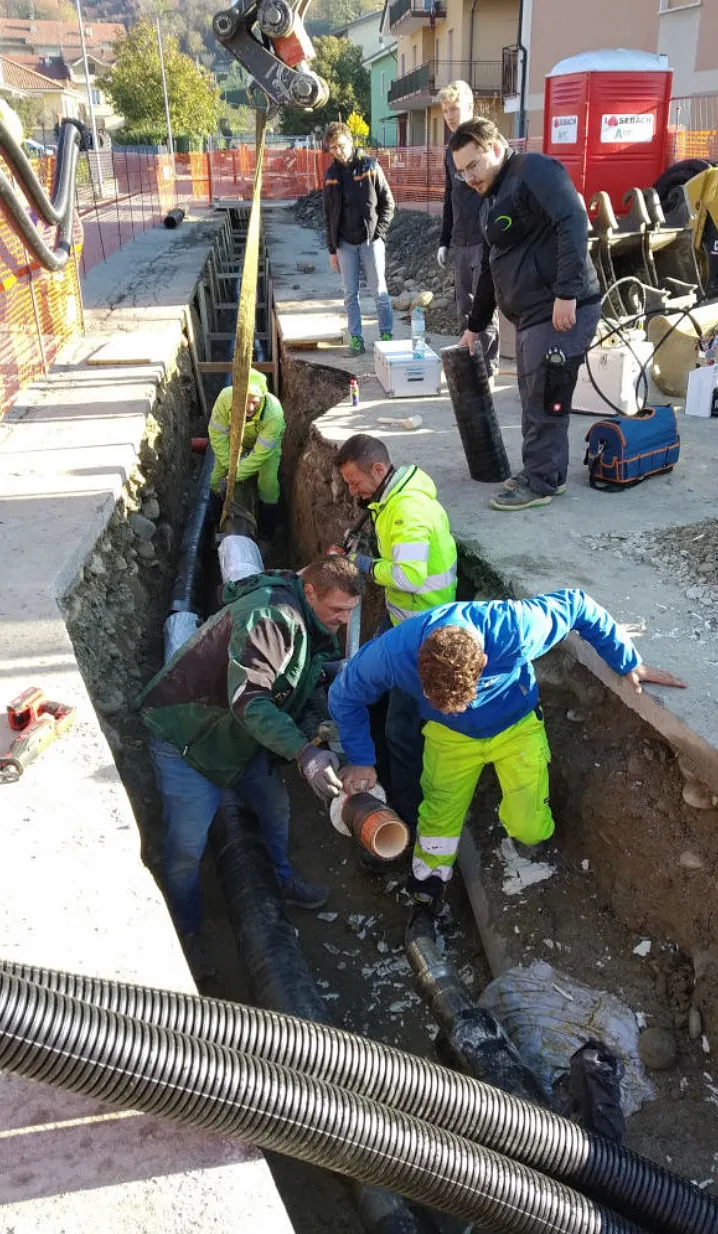
23/09/2025 0 Comments
A Technical Perspective on FibreFlex Innovation: A Case Study
The Municipality of Dogliani, together with Dogliani Energia (part of the Iren Energia Group), is developing its first district heating network with PNRR funding. Beyond the environmental benefits — a reduction of ~1,400 tons of CO₂ per year — the project stands out for its engineering innovation: the replacement of traditional pre-insulated steel pipes with FibreFlex flexible pre-insulated piping systems.
The Municipality of Dogliani, in collaboration with Dogliani Energia of the Iren Energia Group, is currently constructing its first district heating network with funding from the PNRR. Beyond the clear environmental benefit of cutting approximately 1,400 tons of CO₂ emissions annually, equivalent to the yearly emissions of 900 cars, the project is noteworthy for its engineering decision to rely on FibreFlex flexible pre-insulated pipe systems rather than traditional steel pipes. This choice is not only economical but also technically and scientifically advantageous, reshaping the way modern networks are designed and installed.
Conventional pre-insulated steel pipes have been the backbone of district heating for decades. Their robustness and long track record are well recognized, yet they pose substantial limitations. Steel, with its high coefficient of thermal expansion, requires compensating measures such as expansion loops and compensators when exposed to fluctuating temperatures. These additions complicate trench design, widen excavation volumes, and prolong installation. Moreover, steel is inherently vulnerable to corrosion. Even with coatings and protective measures, contact with aggressive soils or groundwater can eventually compromise integrity, leading to higher maintenance costs and the risk of leaks. Steel also conducts heat much more efficiently than composite materials, meaning that heat losses through the pipe wall and at imperfect insulation junctions are comparatively high. Finally, the rigid nature of steel demands extensive welding, prefabricated bends, and a high number of joints, all of which contribute to longer construction timelines and greater potential weak points.
FibreFlex addresses these challenges by introducing a multi-layer composite design. At the core lies a cross-linked polyethylene (PE-Xa) carrier pipe reinforced with fiberglass layers, which provides excellent mechanical stability, high temperature and pressure resistance, and superior fatigue strength under cyclic thermal loading. Surrounding this core is an oxygen diffusion barrier that protects the entire system from internal corrosion. The insulation is provided by high-density polyurethane foam with very low thermal conductivity, and the outer casing is a corrugated high-density polyethylene shell that protects the structure while maintaining flexibility.
This configuration results in clear technical advantages. The flexibility of FibreFlex allows it to be coiled and delivered in lengths of up to several hundred meters, eliminating the need for numerous joints and welds. Where steel requires welding pits every six to twelve meters, FibreFlex can be unrolled continuously into the trench and connected only at necessary junction points, reducing both labor and the risk of leakage. Since the material does not require expansion loops or oversized bends, excavation trenches can remain narrow and shallow. Studies and field experience have demonstrated that excavation volumes are reduced by up to forty percent compared to steel-based systems. The Dogliani project itself illustrates this efficiency: during the first day of installation, eighty meters of FibreFlex network were laid, connected, and backfilled in a single morning, minimizing disruption and allowing the road above to be reopened almost immediately.
The thermal performance is equally significant. Fibre-reinforced polyethylene has a thermal conductivity of roughly 0.4 W/mK, vastly lower than the fifty W/mK typical of steel. Combined with the low lambda values of polyurethane foam insulation, this ensures minimal thermal bridging and a more consistent insulation envelope. Unlike steel systems, FibreFlex does not require additional expansion structures that increase the exposed surface area of the network, thereby preventing unnecessary heat loss. Field comparisons suggest that networks built with FibreFlex achieve on average twenty percent lower thermal losses, which directly translates into reduced operating costs and higher system efficiency over the lifetime of the network.
Durability and lifecycle performance also favor FibreFlex. As a polymer composite system, it is immune to galvanic corrosion and soil-related chemical attack, extending its service life well beyond thirty years without the need for cathodic protection systems. The fiberglass reinforcement helps the material withstand cyclic loads without crack propagation, while the reduced joint density lowers the probability of failures or maintenance interventions. Together, these qualities result in lower operational expenditure and greater service continuity for network operators and end users.
In Dogliani, the engineering team applied FibreFlex in a differentiated manner. The supply line, which requires higher resistance due to elevated operating and peak temperatures, has been designed using FibreFlex Pro capable of withstanding continuous conditions of 95°C and peak temperatures up to 115°C. The return line, which operates under lower temperature conditions, employs the standard FibreFlex variant rated for continuous temperatures of 85°C and peak values up to 95°C. This combination ensures technical robustness where it is required while optimizing material use and overall project economics.
The Dogliani project demonstrates that FibreFlex is more than an alternative to steel; it represents a technological advancement in district heating infrastructure. By reducing excavation and installation costs, minimizing thermal losses, and eliminating corrosion-related risks, the system delivers both immediate and long-term economic benefits. At the same time, it supports sustainability objectives by enhancing energy efficiency and reducing CO₂ emissions. For municipalities and utilities planning to expand or modernize their district heating networks, FibreFlex offers a scientifically sound and economically sustainable path forward.


Comments
Leave a comment